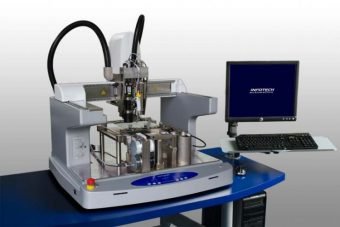Infotech introduced a fully automated system designed to print liquid materials and multi-material structures. Several dispensing heads unite to depose different materials in one printing step. DELO Adhesives‘s high-performance epoxy resins further enable the production of components with a range of different physical properties.
The new system, which was developed based on the proven IP-500 Desktop Dispenser, can be used as a standalone system. The identical machine configuration can be easily adapted to in-line dispensing cells. In the flexible, modular system, DELO devices such as jet valves and LED curing lamps can also be used.
The system is particularly suitable for prototype development and small-series production. Typical areas of application for such components printed with DELO materials include the automotive and microelectronics industries, as the materials are highly resistant to temperature and media and have properties similar to those of high-performance plastics.
The core of the new system is a special dispensing unit that can be equipped with up to three different dispensing valves, thus allowing the creation of multi-material structures. Depending on the properties of the pressure media and the structures to be dispensed, users can choose from a variety of established dispensing valves, such as jet valves, time-pressure valves, or screw dispensing systems. Each valve sits on a separate vertical axis.
Manufacturing on Demand
The dispensing heads operate in parallel, which makes the combination of different liquid materials possible in a single printing process. Linear axes and integrated real-time control ensure maximum dispensing precision while building multi-material structures. The segmentation of the structure and the segments’ allocation to the different dispensing valves are stored in the STL model and correctly implemented in the dispensing pattern by the slicer software. A camera moving along with the robot head detects the exact dispensing position and is simultaneously used to calibrate the dispensing system.
The system cures materials applied in liquid form under UV light, which allows the object to reach its final strength as it is being printed. The effective thickness of the applied layer is determined by a non-contact height measurement. This measurement process allows the working distances of the dispensing units to be dynamically corrected if necessary. The system’s UV lamp head travels along the last-dispensed contour.
The DELO materials for which the system is designed can be used to reliably print components serving different functions. Components with fixed and flexible areas or with transparent and black areas are, for example, all capable of manufacture on this system. Structures with wall thicknesses of less than 500 µm can be produced just as easily as complex structures with overhangs or undercuts.
The entire dispensing and curing process is fully automatic, as is the cleaning of dispensing needles or flat nozzles. Cleaning can be carried out as required, either after a certain number of cycles or components or after a defined period of time.
* This article is reprinted from 3D Printing Media Network. If you are involved in infringement, please contact us to delete it.
Author: Adam Strömbergsson



Leave A Comment